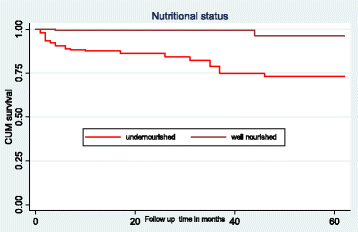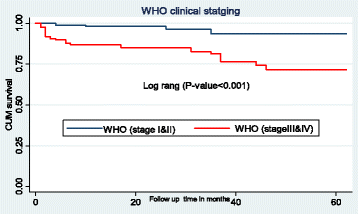Effects of undernutrition on survival of human immunodeficiency virus positive children on antiretroviral therapy
- PMID: 29482600
- PMCID: PMC5828475
- DOI: 10.1186/s13052-018-0472-2
Effects of undernutrition on survival of human immunodeficiency virus positive children on antiretroviral therapy
Abstract
Background: The relationship between undernutrition and HIV is bidirectional, ultimately contributing to quality of life and survival of affected individuals. Ethiopia is a sub-Saharan nation influenced by both undernutrition and HIV. In Ethiopia, although individuals are often dually impacted, the effect of undernutrition on the survival of HIV positive children on anti-retroviral therapy (ART) has not been well investigated. Therefore, this study assessed the effect of undernutrition on survival rates of HIV positive children on ART in Amhara Regional State of Ethiopia.
Methods: An institution-based retrospective cohort study was conducted among 390 HIV positive children on ART from the 1st of January, 2012 to the 28th of February, 2017 in Amhara Regional State Referral Hospitals. A simple random sampling technique was used to select the study participants. Data were extracted by reviewing patients' ART intake and follow-up forms. Data were entered into Epi-Data Version 3.1, and analysis was done using STATA Version 13. The Kaplan-Meier survival curve was used to estimate the cumulative survival time of the sample. Log rank tests were employed to compare the survival time between different categories of explanatory variables. Bivariable and multivariable Cox proportional hazards models were fitted to identify predictors of mortality.
Results: Among the 390 records included in the final analysis, 9.7% of the individuals died within the follow-up period. In this study, the overall mortality rate was found to be 4.4 per 100 child-years (95% CI: 3.2, 6.0) while undernourished children had a lower survival time than well-nourished children. Low hemoglobin level (AHR: 3.2, 95% CI: 1.4, 7.4), CD4 cell count or percent below the threshold (AHR: 5.2, 95% CI: 1.9, 14.1), severe stunting (AHR: 3.9, 95% CI: 1.7, 9.4), severe wasting (AHR: 3.0, 95% CI: 1.3, 6.9) and advanced disease stage (III and IV) (AHR: 2.6, 95% CI: 1.1, 6.6) were found to be predictors of mortality.
Conclusion: There was a high rate of mortality. A significant difference was observed in the survival rate of undernourished and well-nourished children. Low hemoglobin level, CD4 count or percent below the threshold, severe wasting, severe stunting, and advanced disease stage were found to be predictors of mortality.
Keywords: Anti-retroviral therapy (ART); Children; HIV; Mortality; Undernutrition.
Conflict of interest statement
Ethics approval and consent to participate
Ethical clearance was obtained from an institutional review committee of the School of Nursing, College of Medicine and Health Sciences, University of Gondar. The ethics committee formally waived the need for formal written consent since the study was done through retrospective reviews of patient cards (charts). Permission letter was obtained from each hospital administration. Since, the study was reviewed medical records; the individual patients were minimally at risk for harm as confidentiality was likely to be attainable. To maintain confidentiality, collected data were coded and locked in a separate room. After entry into the computer, all data were locked by password; as well, names and unique ART numbers were not included in the data collection format.
Consent for publication
Not applicable
Competing interests
The authors have declared that they have no competing interests.
Publisher’s Note
Springer Nature remains neutral with regard to jurisdictional claims in published maps and institutional affiliations.
Figures




References
-
- UNICEF: Towards an AIDS-free generation: children and AIDS: sixth stocktaking report, 2013. 2013. Available from http://www.unaids.org/sites/default/files/media_asset/20131129_stocktaki....
-
- Kedir AA, Desta A, Fesseha G. Factors affecting survival of HIV positive children taking antiretroviral therapy at Adama referral hospital and medical college, Ethiopia. J AIDS Clin Res. 2014;2014
-
- UNIAS: UNAIDS data 2017. 2017. Available at www.unaids.org/sites/default/files/media_asset/20170720_Data_book_2017_e....
-
- The Ethiopian Public Health Institute: HIV related estimates and projections for Ethiopia–2017. 2017. Available at https://www.ephi.gov.et/images/pictures/download2009/HIV_estimation_and_....
Publication types
MeSH terms
Substances
LinkOut - more resources
Full Text Sources
Other Literature Sources
Medical
Research Materials

